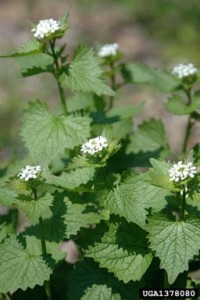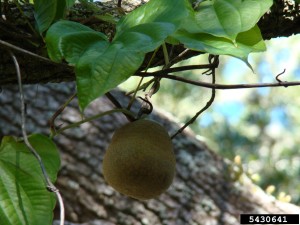garlic mustard; Chris Evans,River to River CWMA; Bugwood
As we all know, the United States is overrun by non-native plants. As I noted in blogs posted in January and March, Rod Randall’s database lists more than 9,700 non-native plant species as naturalized in the U.S. Not all 9,700 cause environmental damage. But hundreds do – a fact attested to by the various regional Invasive Plant and Exotic Pest Plant councils:
- The Southeast Exotic Pest Plant Council lists approximately 400 invasive species.
- The Mid-Atlantic Invasive Plant Council lists 285 invasive plants.
- The Midwest Invasive Plant Network says the state agencies or state-level invasive plant councils in its region list more than 270 plant species as invasive, noxious, or pest species in the Midwest.
- The California Invasive Plant Council lists 208.
- Texas Invasives reports that there are more than 800 non-indigenous plant species in the state, of which 20 are considered invasive.
The Pacific Northwest and Northern Rockies councils do not provide lists on their websites.
The analysis of forest inventory data by Christopher Oswalt and colleagues — discussed in my blog in March — found that almost 40% of forest plots in the United States are invaded by alien plant species. Other than in Hawai`i, the most invaded region is forests in the eastern United States – where 46% of forest plots in the East harbor one or more of the invasive plant species included in the inventory process.
The March and earlier blogs discuss reasons why the invasive plant situation is likely to worsen over time.
Given the geographic extent of plant invasions and the environmental complications, expense, and other difficulties associated with managing invasive plants using mechanical or chemical tools, many place their hope in biological control. Scientists in the U.S. Forest Service, Agriculture Research Service, U.S Geological Survey, academia, and other institutions have devoted years to identifying promising biocontrol agents targeting some of the most widespread and damaging invasive plants.
Possible biocontrol agents have been identified for numerous invasive plant species … but relatively few have been approved for release.
Part of the delay is attributable to the necessity for caution to ensure that biocontrol agents are effective and do not become damaging invasive themselves. This concern underlies the legal requirement that non-native biocontrol agents must be approved by USDA APHIS. APHIS permits are required for
- Importation of live biocontrol agents into the U.S. or its territories
- Interstate movement of live biocontrol agents (USDA policy allows movement of certain commercial entomophagous biocontrol agents without a permit)
- Retaining live biocontrol agents after expiration of a permit
- Movement of any live biocontrol agent from confinements of containment facility or for release into the environment.
The approval process is lengthy and complex – and frustrating! Its many steps were outlined in a presentation by a staffer in APHIS’ permit branch, Robert Tichenor, available here
As noted in the presentation, the process can take a decade or more between scientists initiating the search for possible agents to final approval. The scientists hoping to find useful biocontrol agents face possibly years of work to identify and obtain organisms that seem promising as biocontrol agents. The petitioner must then screen the putative agent(s) for efficacy and then for host specificity. Once this work has been completed, the scientist prepares a petition to APHIS asking that it approve release of the biocontrol agent(s).
At this stage, government agencies take over. When it receives a petition for release of a biocontrol agent, APHIS sends the petition to the Technical Advisory Group (TAG). (For details about the TAG, go here.
Under the TAG charter, APHIS invites the following agencies to provide a representative to serve on the TAG: Army Corps of Engineers, Environmental Protection Agency; Department of Agriculture: APHIS, Agricultural Research Service, Forest Service, National Institute of Food and Agriculture, Natural Resource Conservation Service; Department of the Interior: Bureau of Indian Affairs, Bureau of Land Management, Bureau of Reclamation, National Park Service, Fish and Wildlife Service, Geological Survey. APHIS may also invite participation by State or other Federal government employees (one each) to represent the National Plant Board, Weed Science Society of America, and other Federal Agencies expressing interest. Canada and Mexico are also asked their views.
The TAG reviews both the proposed plant list for host specificity testing and the petition for first-time field release. The TAG may suggest inclusion of certain test plants, identify conflicts of interest, and assess potential risks associated with an environmental release. In making their evaluations, TAG members are expected to represent their agency’s or organization’s perspective. The chairman seeks to build consensus. Then s/he conveys the recommendations to APHIS.
APHIS decides whether to proceed with the review process and so informs the petitioner and APHIS’ Policy and Program Development (PPD) division. Using information in the Petition, APHIS prepares a Biological Assessment analyzing whether releasing the biocontrol agent might affect a species listed as endangered or threatened under the Endangered Species Act. This Biological Assessment is sent to the US Fish and Wildlife Service (FWS) to initiate an “informal” consultation per Section 7 of the Endangered Species Act (16 U.S.C. Section 1536). The FWS’ review can take more than a year and can involve requests for additional information. For the proposed biocontrol project to proceed, APHIS must receive a letter from US FWS stating that US FWS “concurs” with APHIS’ determination that release of the biocontrol agent is “not likely to adversely affect” listed species or designated Critical Habitat.
Upon receipt of the FWS concurrence letter, APHIS begins preparing an environmental assessment (EA), and consults with any affected Native American tribes. The draft EA is released for public comment, usually for a period of 30 days. Once the comments are received, APHIS reviews and responds to the comments, and issues the final EA and accompanying Finding of No Significant Impact (FONSI). A month later, the permit is issued to remove the biocontrol agent form containment and release it into the environment.
While APHIS normally waits for FWS approval before beginning the NEPA review – because APHIS cannot complete the FONSI until it receives FWS concurrence – staff are now considering ways to speed up the process.
This already lengthy process has been further hampered by retirement of key staff in both APHIS and the FWS. New staff were also probably more cautious about approving agents because of the controversy over the potential impact of biocontrol agents’ success in reducing populations of tamarisk (Tamarix spp.) on nesting habitat for the endangered southwest willow flycatcher.
Finally, the process itself causes delays. Petitioners are required to re-submit their proposal to the Technical Advisory Group each time it is revised to address a question raised by a reviewer. These requirements can cause delay and probably frustrate the petitioners.
Current status of weed biocontrol programs
air potato; Rebekah D. Wallace, University of Georgia; bugwood.org
The current status of weed biocontrol is partially revealed at this site, which shows the status of TAG and APHIS actions. Some 36 biocontrol agents proposed for field release have been reviewed by the TAG since 2010. Of these, two have completed the review process and been approved by APHIS for release: agents targeting hawkweeds (Hieracium spp.) and air potato (Dioscorea bulbifera). Both were approved in 2011. In his presentation, Dr. Tichenor said a third insect – a gall fly targeting Cape Ivy (Delairea odorata) – received a permit allowing release into the environment in May 2016.
The 33 other biocontrol agents that were approved by the TAG are still in other stages of the approval process. Dr. Tichenor reported that an environmental assessment is now being written for a leaf mining fly (Lasioptera donacis) intended to control Arundo (this agent was approved by the TAG only in April 2016 – remarkable speed in obtaining FWS clearance). Three agents are nearing the end of the Endangered Species Act §7 consultation process; these are agents targeting yellow toadflax (Linaria vulgaris), hoary cress (Lepidium draba), and the two swallow-worts (Cynanchum louiseae or Vincetoxicum nigrum; and Cynanchum rossicum or Vincetoxicum rossicum). APHIS has asked for additional information on two agents – targeting gorse and several knotweed species.
One agent intended for use against garlic mustard was rejected by the TAG in 2009. A second agent is still under review by the TAG.
The other four species approved by the TAG in 2016 to date are presumably at the early stage of the biological assessment; these include two agents for Brazilian pepper, a beetle for Chinese tallowtree, and another insect targeting hawkweeds (genus now given as Pilosella).
Since 2010, the TAG has recommended against field release for eight proposed biocontrol agents. These included species intended to control Chinese privet (Ligustrum sinense), Russian thistle (Salsola tragus), and Russian knapweed (Rhaponticum repens). The TAG asked for additional information on four species.
Of course, garlic mustard and Chinese privet are among the top five most frequently detected invaders in the forest inventory study – garlic mustard in the Mid-Atlantic and Northeast, privet in the Southeast.
A fungus (Verticillium nonalfalfae ) is under study as a biocontrol agent for another widespread invasive plant, Ailanthus (tree of heaven). Research by USDA Forest Service scientists have found that a few native species of shrubs and trees are also mildly sensitive to the fungus. Testing of additional native and agricultural species continues. The fungus occurs naturally in North America so it is not subject to the approval process described here.
An introduced insect, spotted lanternfly (Lycorma delicatula) also attacks Ailanthus. The lanternfly attacks a wide range of woody plants, including grapes and fruit trees. Consequently, Pennsylvania is attempting to eradicate it from the four counties in the eastern part of the state where it has been found.
Hundreds of invasive plant species are damaging ecosystems across the country. Biocontrol is one of the few tools available to counter the threat from invasive species – plants and others. I hope people concerned about invasive species will increase efforts to identify those bioinvaders for which biocontrol appears to offer promise, then to seek out potential biocontrol agents. And that regulatory bodies improve their ability to evaluate proposals promptly – while still being thorough. Doing nothing causes real harm.
Posed by Faith Campbell

